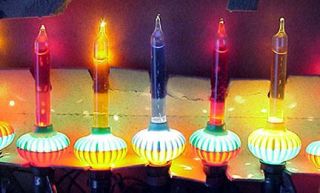Friends
Coolest Kid on the Block—Christmas Tree AND Hanukkah Bush!
I’ve been blessed to celebrate both Hanukkah and Christmas.
Posted December 7, 2012
This is heavenly for me: it's time to celebrate Hanukkah and Christmas together!

Hanukkah is celebrated according to the Jewish calendar. The calendar that we use every day (the Gregorian) is based on the earth’s movement around the sun, but the Jewish calendar is based on both the sun and the moon. A year on the Jewish calendar varies from 353-385 days, so Hanukkah doesn’t take place on the Gregorian calendar at the same time every year. Hanukkah can start any time from late November to late December.
My parents were Jewish but they weren’t religious. Instead of turning away from holiday celebrations, they embraced all of them. I grew up lighting Hanukkah candles, decorating the Christmas tree, and singing Hanukkah songs and Christmas carols to the accompaniment of my mother on the piano. (Do any of you remember The Fireside Folksong book? I still have our family’s copy—tattered though it is.)
Some of our relatives disapproved of my parents’ holiday traditions and refused to come to our house in December because of our Christmas tree. Some of the parents of my Christian friends disapproved too. But my friends—Jewish and Christian alike—thought I was the coolest kid on the block because I got to celebrate both holidays.
Hanukkah lasts for eight days and nights. Using a candelabra called a menorah, one candle is lit on the first night of Hanukkah, two on the second night, and so on, progressing to eight on the last night. Hanukkah celebrates religious freedom. It commemorates the 165 B.C. victory of the Maccabees, a Jewish army, over the Syrians, and the recapture of the holy temple in Jerusalem. When the Maccabees decided to rededicate the temple, they could only find enough temple oil to burn for one night. Miraculously, it burned for eight days and nights. When I was a child, I loved putting the proper number of candles into the menorah each morning in preparation for lighting them at sundown.

I also loved decorating our Christmas tree each year. How I loved those glass bubble lights! I’d patiently wait for the them to be plugged in at sunset and for the colored liquid to start heating. Then I inspected each light individually, flicking my finger on the glass of those that were slow to start bubbling.
I remember how special it was when one of the eight nights of Hanukkah overlapped with Christmas—we’d light our Hanukkah candles as our Christmas tree glowed (and bubbled) nearby. This gave me double duty at sundown: get those Hanukkah candles lit and get those bubble lights bubbling!
Interestingly, until the 19th Century, Hanukkah was a relatively minor Jewish holiday in the United States—perhaps the equivalent of Flag Day. But because of all the holiday activity surrounding Christmas, Jewish families began to celebrate Hanukkah so their children wouldn’t feel left out this time of year. Now it’s so well-known that it’s depicted in movies and in contemporary songs—my favorite being Adam Sandler’s “The Hanukkah Song” (“Put on your yarmulke, here comes Hanukkah!”)
When my father died unexpectedly just before Hanukkah and Christmas one year, my mother tried to brighten this terrible time by adding a “Hanukkah bush” to the mix. We bought a tiny tree at our local Christmas tree lot. Then we went through our Christmas ornaments, picking out the blue and white ones—the traditional colors of Hanukkah—and decorated our Hanukkah bush. From that year on, we had a menorah, a Christmas tree, and a Hanukkah bush.
When I got married, it was easy for me to carry on the Christmas tradition because my husband’s family celebrated Christmas in grand style. We’d go to candlelight services on Christmas Eve at the Unitarian Church in San Francisco and, from this, I learned more about the true meaning of Christmas. My father-in-law became my Santa Claus because he embodied the spirit of generosity and good cheer.
I also continued to celebrate Hanukkah, at first just with my husband and then with our two children. For several years when our kids were young, we couldn’t afford a menorah. I’d buy a box of Hanukkah candles (they were only a buck) and, using a match to melt the wax bottoms, I’d stick them onto a brick, increasing the number of candles by one each night. By the time we reached the eighth night, it was a quite a challenge to set up the “menorah” each morning: I had to melt the bottom of each candle and try to fit them all onto that small brick, keeping them relatively parallel to each other. Half the time, I’d knock one over after I’d already carefully melted it in place.
Last year, our bronze menorah broke. How does one go about getting a menorah these days? Why, at menorah.com of course.
I always think about my parents this time of year. I’m certain they’d have gradually added other holidays into the mix for us to celebrate—from Kwanza to the Winter Solstice—maybe even Festivus!
Happy Holidays to my online friends all over the world.
© 2012 Toni Bernhard. Thank you for reading my work. I'm the author of four books:
How to Be Sick: Your Pocket Companion (for those who've read How to Be Sick and for those who haven't) 2020
How to Live Well with Chronic Pain and Illness: A Mindful Guide (2015)
How to Wake Up: A Buddhist-Inspired Guide to Navigating Joy and Sorrow (2013)
All of my books are available in audio format from Amazon, audible.com, and iTunes.
Visit www.tonibernhard.com for more information and buying options.
Using the envelope icon, you can email this piece to others. I'm active on Facebook, Pinterest, and Twitter.




